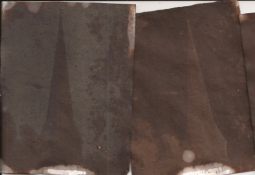I'm an amateur at darkroom stuff, having only been doing this for three months or so, since I inherited a darkroom and some old cameras. The last few weeks I've been trying salt printing - it's been really fun.
My first time trying it I made a basic salt solution, coated the paper, added the silver, and exposed three prints from the same transparency. All three worked (unexpectedly - thought I make a mess of it first time).
The weirdness: two of them came out negative, one of them came out as positive.
I have no idea how I managed this. Anyone help me out here?
My first time trying it I made a basic salt solution, coated the paper, added the silver, and exposed three prints from the same transparency. All three worked (unexpectedly - thought I make a mess of it first time).
The weirdness: two of them came out negative, one of them came out as positive.
I have no idea how I managed this. Anyone help me out here?











